Research Skills 2: Understanding Summaries, Paraphrasing, and Reports
VerifiedAdded on 2022/10/04
|7
|1478
|20
Report
AI Summary
This research report delves into essential research skills, beginning with a clear distinction between summarizing and paraphrasing, emphasizing their roles in condensing and restating information while maintaining accuracy. The report provides practical strategies for avoiding plagiarism, including proper paraphrasing techniques, incorporating additional information, utilizing plagiarism checkers, and adhering to correct citation methods. It then contrasts technical and long reports, outlining their respective purposes and structures. Furthermore, the report meticulously details the six crucial components of a research report: abstract, introduction, methodology, results, discussion, and references. Each component is explained, providing a comprehensive understanding of report structure and content. The references section lists all the sources cited in the report.

Running head: RESEARCH SKILLS 1
Research Skills
Name of Author
Institution of Affiliation
Date of Submission
Research Skills
Name of Author
Institution of Affiliation
Date of Submission
Paraphrase This Document
Need a fresh take? Get an instant paraphrase of this document with our AI Paraphraser
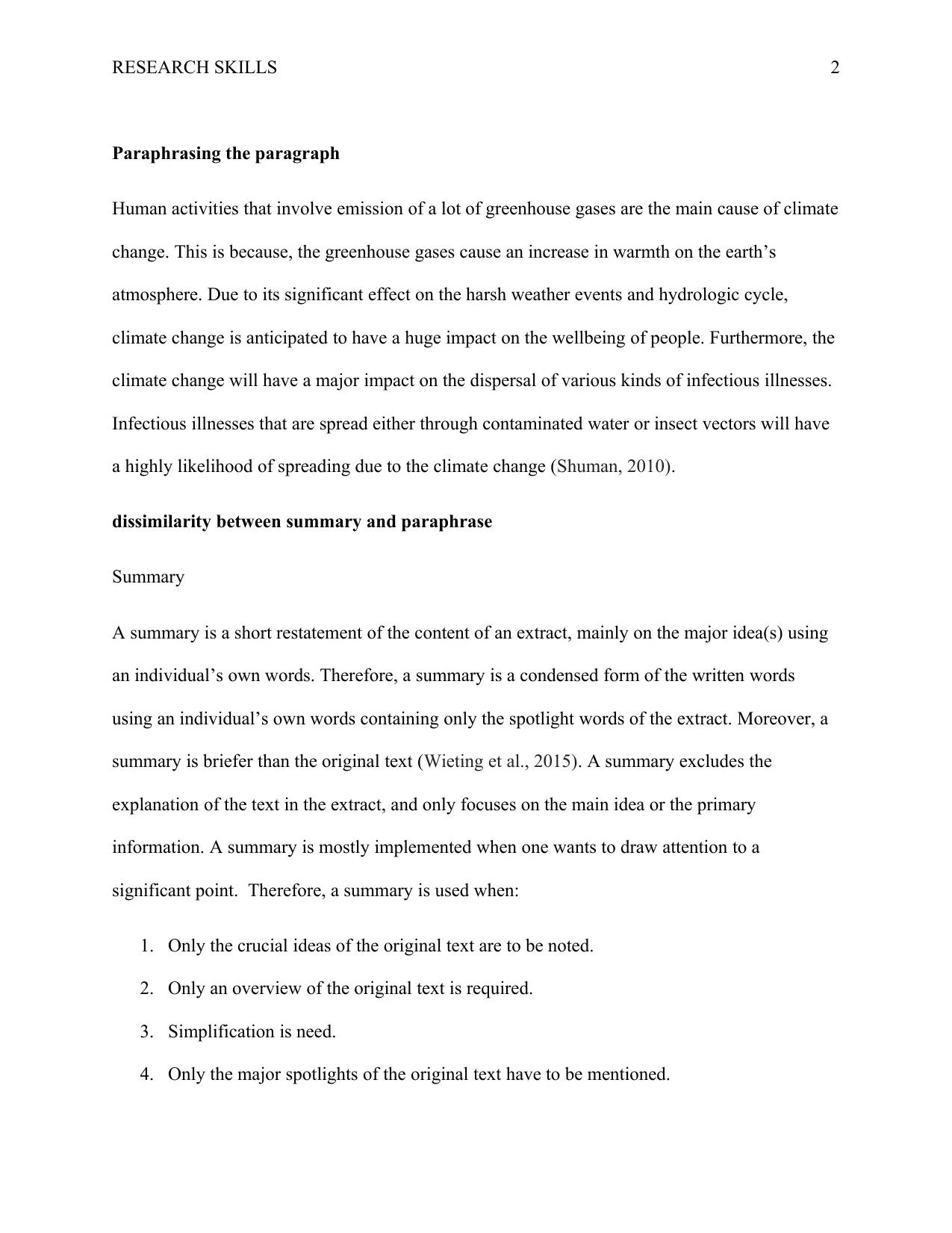
RESEARCH SKILLS 2
Paraphrasing the paragraph
Human activities that involve emission of a lot of greenhouse gases are the main cause of climate
change. This is because, the greenhouse gases cause an increase in warmth on the earth’s
atmosphere. Due to its significant effect on the harsh weather events and hydrologic cycle,
climate change is anticipated to have a huge impact on the wellbeing of people. Furthermore, the
climate change will have a major impact on the dispersal of various kinds of infectious illnesses.
Infectious illnesses that are spread either through contaminated water or insect vectors will have
a highly likelihood of spreading due to the climate change (Shuman, 2010).
dissimilarity between summary and paraphrase
Summary
A summary is a short restatement of the content of an extract, mainly on the major idea(s) using
an individual’s own words. Therefore, a summary is a condensed form of the written words
using an individual’s own words containing only the spotlight words of the extract. Moreover, a
summary is briefer than the original text (Wieting et al., 2015). A summary excludes the
explanation of the text in the extract, and only focuses on the main idea or the primary
information. A summary is mostly implemented when one wants to draw attention to a
significant point. Therefore, a summary is used when:
1. Only the crucial ideas of the original text are to be noted.
2. Only an overview of the original text is required.
3. Simplification is need.
4. Only the major spotlights of the original text have to be mentioned.
Paraphrasing the paragraph
Human activities that involve emission of a lot of greenhouse gases are the main cause of climate
change. This is because, the greenhouse gases cause an increase in warmth on the earth’s
atmosphere. Due to its significant effect on the harsh weather events and hydrologic cycle,
climate change is anticipated to have a huge impact on the wellbeing of people. Furthermore, the
climate change will have a major impact on the dispersal of various kinds of infectious illnesses.
Infectious illnesses that are spread either through contaminated water or insect vectors will have
a highly likelihood of spreading due to the climate change (Shuman, 2010).
dissimilarity between summary and paraphrase
Summary
A summary is a short restatement of the content of an extract, mainly on the major idea(s) using
an individual’s own words. Therefore, a summary is a condensed form of the written words
using an individual’s own words containing only the spotlight words of the extract. Moreover, a
summary is briefer than the original text (Wieting et al., 2015). A summary excludes the
explanation of the text in the extract, and only focuses on the main idea or the primary
information. A summary is mostly implemented when one wants to draw attention to a
significant point. Therefore, a summary is used when:
1. Only the crucial ideas of the original text are to be noted.
2. Only an overview of the original text is required.
3. Simplification is need.
4. Only the major spotlights of the original text have to be mentioned.
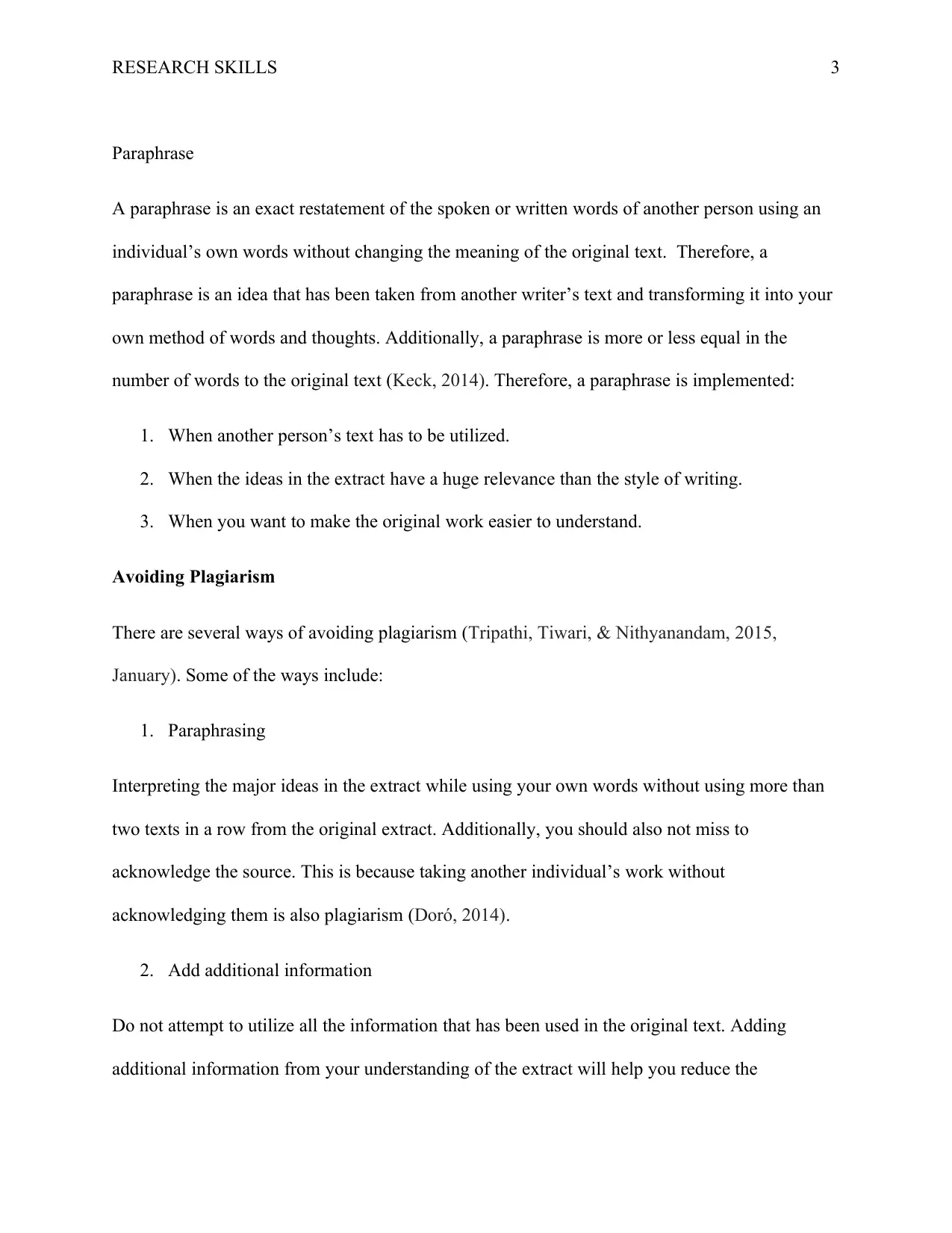
RESEARCH SKILLS 3
Paraphrase
A paraphrase is an exact restatement of the spoken or written words of another person using an
individual’s own words without changing the meaning of the original text. Therefore, a
paraphrase is an idea that has been taken from another writer’s text and transforming it into your
own method of words and thoughts. Additionally, a paraphrase is more or less equal in the
number of words to the original text (Keck, 2014). Therefore, a paraphrase is implemented:
1. When another person’s text has to be utilized.
2. When the ideas in the extract have a huge relevance than the style of writing.
3. When you want to make the original work easier to understand.
Avoiding Plagiarism
There are several ways of avoiding plagiarism (Tripathi, Tiwari, & Nithyanandam, 2015,
January). Some of the ways include:
1. Paraphrasing
Interpreting the major ideas in the extract while using your own words without using more than
two texts in a row from the original extract. Additionally, you should also not miss to
acknowledge the source. This is because taking another individual’s work without
acknowledging them is also plagiarism (Doró, 2014).
2. Add additional information
Do not attempt to utilize all the information that has been used in the original text. Adding
additional information from your understanding of the extract will help you reduce the
Paraphrase
A paraphrase is an exact restatement of the spoken or written words of another person using an
individual’s own words without changing the meaning of the original text. Therefore, a
paraphrase is an idea that has been taken from another writer’s text and transforming it into your
own method of words and thoughts. Additionally, a paraphrase is more or less equal in the
number of words to the original text (Keck, 2014). Therefore, a paraphrase is implemented:
1. When another person’s text has to be utilized.
2. When the ideas in the extract have a huge relevance than the style of writing.
3. When you want to make the original work easier to understand.
Avoiding Plagiarism
There are several ways of avoiding plagiarism (Tripathi, Tiwari, & Nithyanandam, 2015,
January). Some of the ways include:
1. Paraphrasing
Interpreting the major ideas in the extract while using your own words without using more than
two texts in a row from the original extract. Additionally, you should also not miss to
acknowledge the source. This is because taking another individual’s work without
acknowledging them is also plagiarism (Doró, 2014).
2. Add additional information
Do not attempt to utilize all the information that has been used in the original text. Adding
additional information from your understanding of the extract will help you reduce the
⊘ This is a preview!⊘
Do you want full access?
Subscribe today to unlock all pages.

Trusted by 1+ million students worldwide
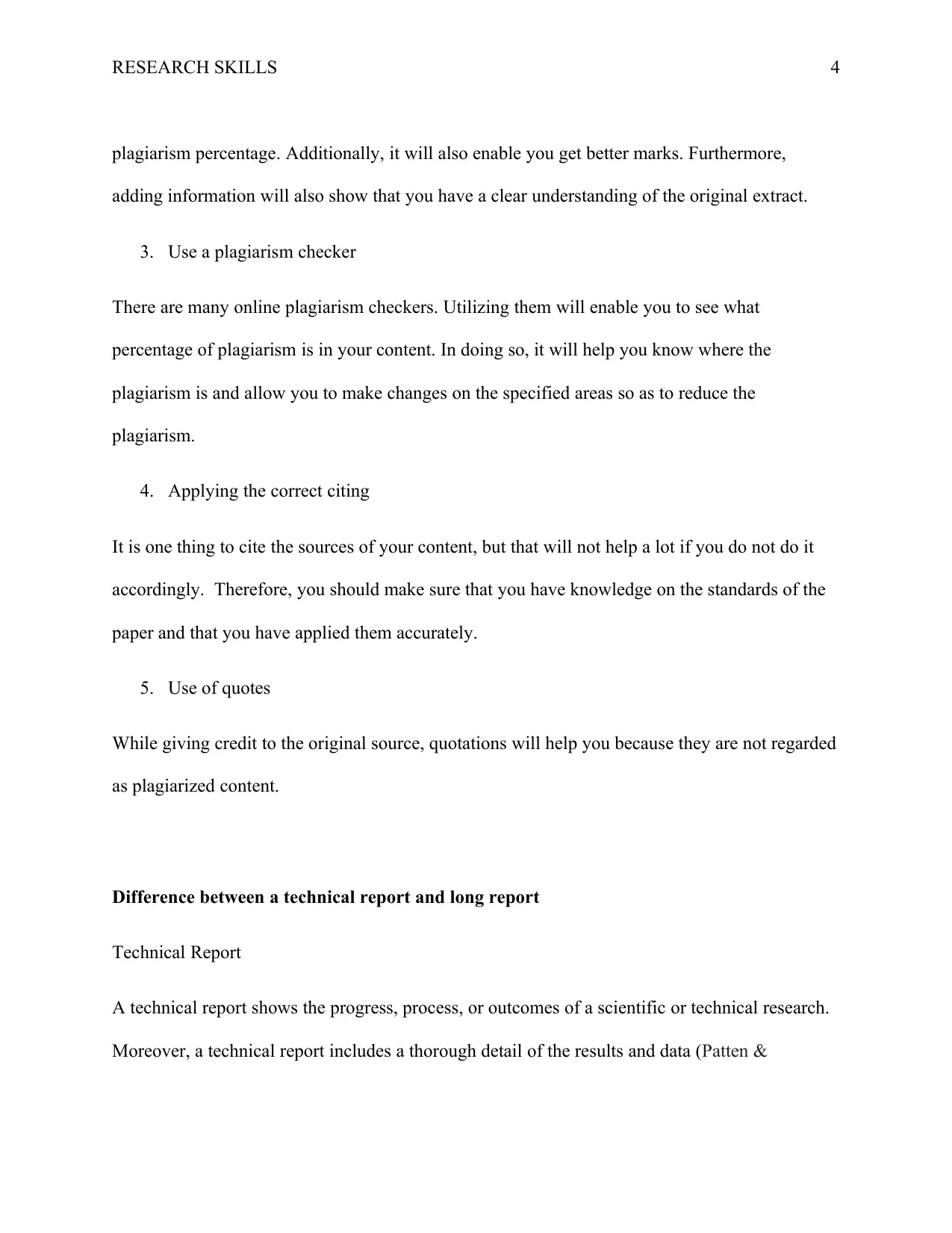
RESEARCH SKILLS 4
plagiarism percentage. Additionally, it will also enable you get better marks. Furthermore,
adding information will also show that you have a clear understanding of the original extract.
3. Use a plagiarism checker
There are many online plagiarism checkers. Utilizing them will enable you to see what
percentage of plagiarism is in your content. In doing so, it will help you know where the
plagiarism is and allow you to make changes on the specified areas so as to reduce the
plagiarism.
4. Applying the correct citing
It is one thing to cite the sources of your content, but that will not help a lot if you do not do it
accordingly. Therefore, you should make sure that you have knowledge on the standards of the
paper and that you have applied them accurately.
5. Use of quotes
While giving credit to the original source, quotations will help you because they are not regarded
as plagiarized content.
Difference between a technical report and long report
Technical Report
A technical report shows the progress, process, or outcomes of a scientific or technical research.
Moreover, a technical report includes a thorough detail of the results and data (Patten &
plagiarism percentage. Additionally, it will also enable you get better marks. Furthermore,
adding information will also show that you have a clear understanding of the original extract.
3. Use a plagiarism checker
There are many online plagiarism checkers. Utilizing them will enable you to see what
percentage of plagiarism is in your content. In doing so, it will help you know where the
plagiarism is and allow you to make changes on the specified areas so as to reduce the
plagiarism.
4. Applying the correct citing
It is one thing to cite the sources of your content, but that will not help a lot if you do not do it
accordingly. Therefore, you should make sure that you have knowledge on the standards of the
paper and that you have applied them accurately.
5. Use of quotes
While giving credit to the original source, quotations will help you because they are not regarded
as plagiarized content.
Difference between a technical report and long report
Technical Report
A technical report shows the progress, process, or outcomes of a scientific or technical research.
Moreover, a technical report includes a thorough detail of the results and data (Patten &
Paraphrase This Document
Need a fresh take? Get an instant paraphrase of this document with our AI Paraphraser
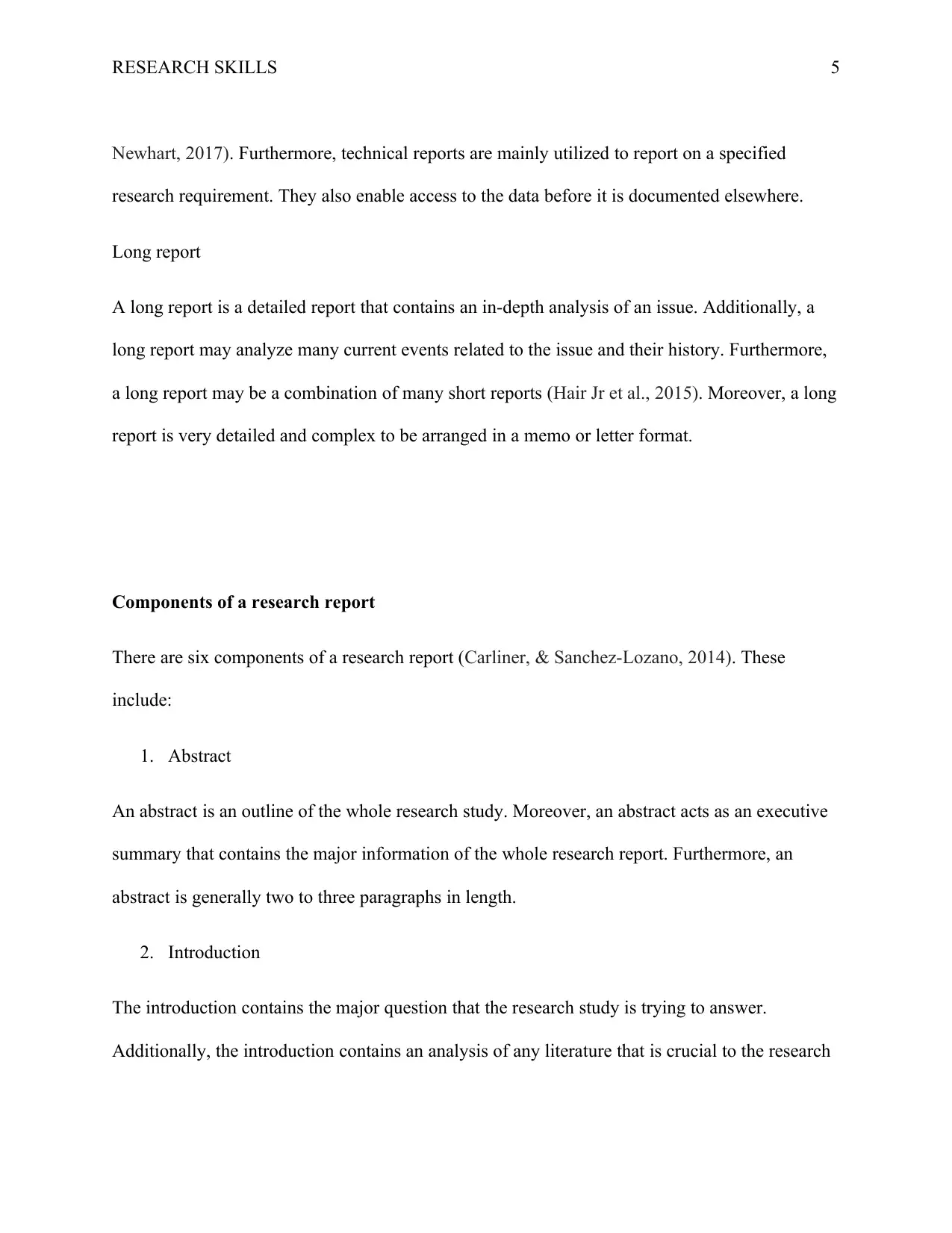
RESEARCH SKILLS 5
Newhart, 2017). Furthermore, technical reports are mainly utilized to report on a specified
research requirement. They also enable access to the data before it is documented elsewhere.
Long report
A long report is a detailed report that contains an in-depth analysis of an issue. Additionally, a
long report may analyze many current events related to the issue and their history. Furthermore,
a long report may be a combination of many short reports (Hair Jr et al., 2015). Moreover, a long
report is very detailed and complex to be arranged in a memo or letter format.
Components of a research report
There are six components of a research report (Carliner, & Sanchez-Lozano, 2014). These
include:
1. Abstract
An abstract is an outline of the whole research study. Moreover, an abstract acts as an executive
summary that contains the major information of the whole research report. Furthermore, an
abstract is generally two to three paragraphs in length.
2. Introduction
The introduction contains the major question that the research study is trying to answer.
Additionally, the introduction contains an analysis of any literature that is crucial to the research
Newhart, 2017). Furthermore, technical reports are mainly utilized to report on a specified
research requirement. They also enable access to the data before it is documented elsewhere.
Long report
A long report is a detailed report that contains an in-depth analysis of an issue. Additionally, a
long report may analyze many current events related to the issue and their history. Furthermore,
a long report may be a combination of many short reports (Hair Jr et al., 2015). Moreover, a long
report is very detailed and complex to be arranged in a memo or letter format.
Components of a research report
There are six components of a research report (Carliner, & Sanchez-Lozano, 2014). These
include:
1. Abstract
An abstract is an outline of the whole research study. Moreover, an abstract acts as an executive
summary that contains the major information of the whole research report. Furthermore, an
abstract is generally two to three paragraphs in length.
2. Introduction
The introduction contains the major question that the research study is trying to answer.
Additionally, the introduction contains an analysis of any literature that is crucial to the research
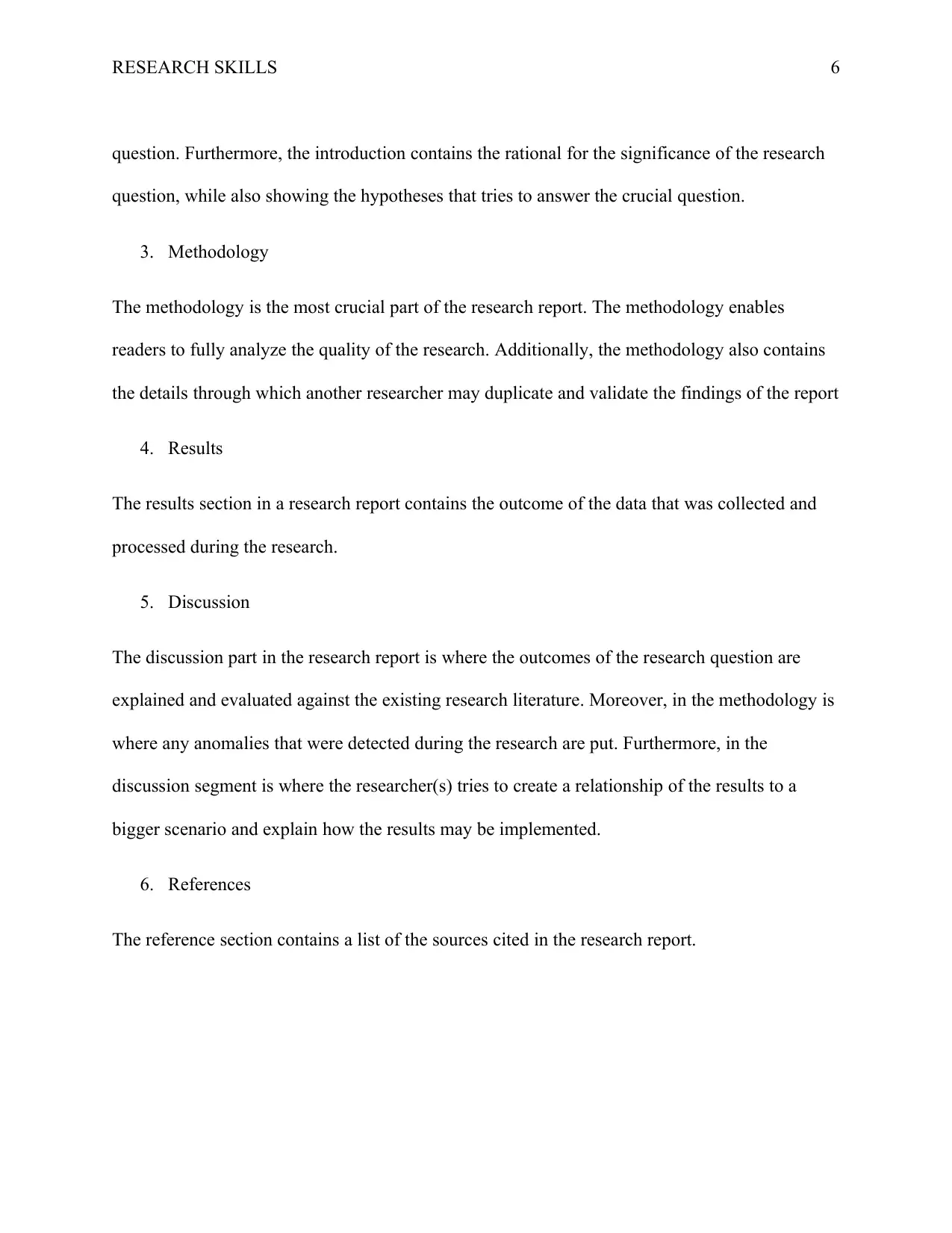
RESEARCH SKILLS 6
question. Furthermore, the introduction contains the rational for the significance of the research
question, while also showing the hypotheses that tries to answer the crucial question.
3. Methodology
The methodology is the most crucial part of the research report. The methodology enables
readers to fully analyze the quality of the research. Additionally, the methodology also contains
the details through which another researcher may duplicate and validate the findings of the report
4. Results
The results section in a research report contains the outcome of the data that was collected and
processed during the research.
5. Discussion
The discussion part in the research report is where the outcomes of the research question are
explained and evaluated against the existing research literature. Moreover, in the methodology is
where any anomalies that were detected during the research are put. Furthermore, in the
discussion segment is where the researcher(s) tries to create a relationship of the results to a
bigger scenario and explain how the results may be implemented.
6. References
The reference section contains a list of the sources cited in the research report.
question. Furthermore, the introduction contains the rational for the significance of the research
question, while also showing the hypotheses that tries to answer the crucial question.
3. Methodology
The methodology is the most crucial part of the research report. The methodology enables
readers to fully analyze the quality of the research. Additionally, the methodology also contains
the details through which another researcher may duplicate and validate the findings of the report
4. Results
The results section in a research report contains the outcome of the data that was collected and
processed during the research.
5. Discussion
The discussion part in the research report is where the outcomes of the research question are
explained and evaluated against the existing research literature. Moreover, in the methodology is
where any anomalies that were detected during the research are put. Furthermore, in the
discussion segment is where the researcher(s) tries to create a relationship of the results to a
bigger scenario and explain how the results may be implemented.
6. References
The reference section contains a list of the sources cited in the research report.
⊘ This is a preview!⊘
Do you want full access?
Subscribe today to unlock all pages.

Trusted by 1+ million students worldwide
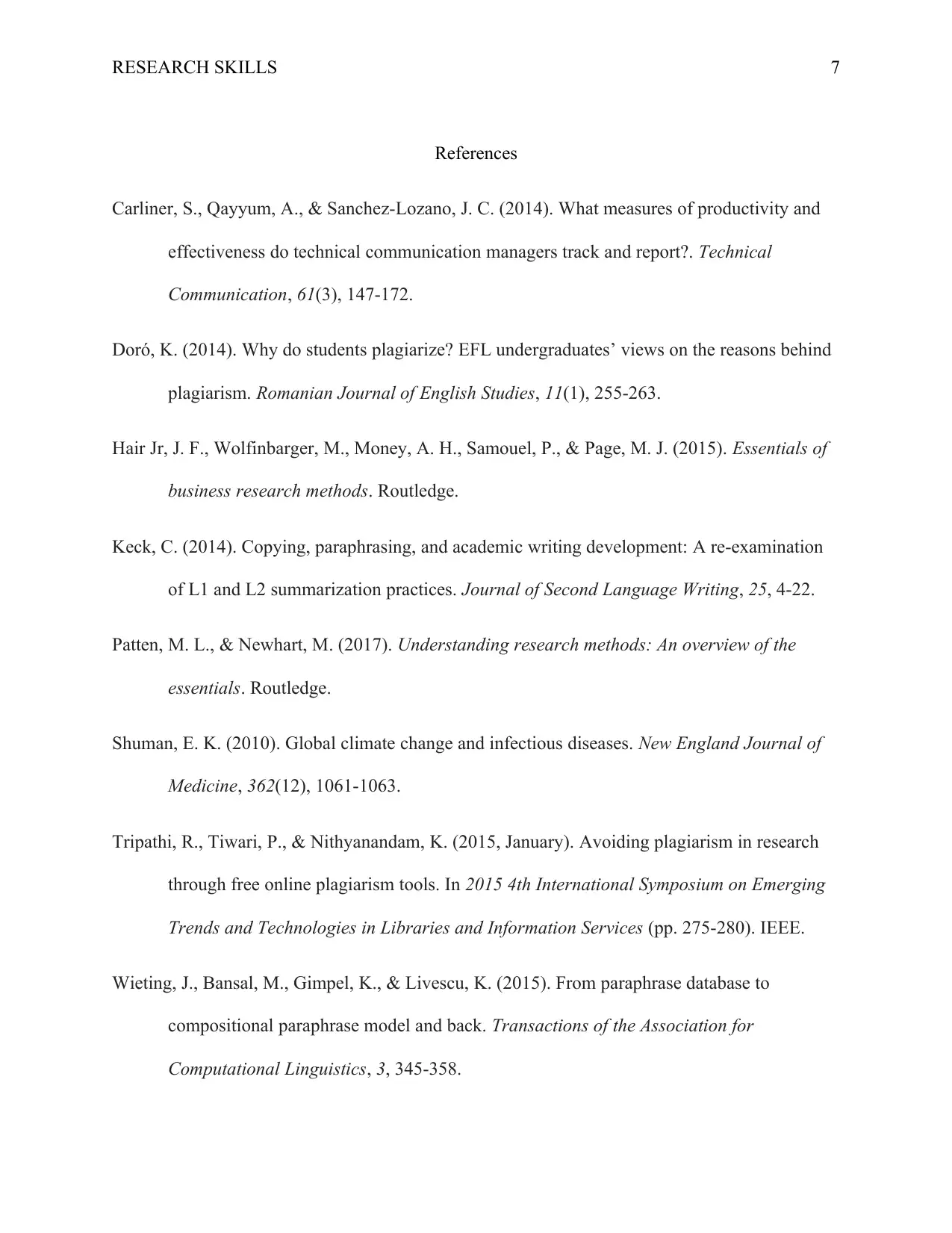
RESEARCH SKILLS 7
References
Carliner, S., Qayyum, A., & Sanchez-Lozano, J. C. (2014). What measures of productivity and
effectiveness do technical communication managers track and report?. Technical
Communication, 61(3), 147-172.
Doró, K. (2014). Why do students plagiarize? EFL undergraduates’ views on the reasons behind
plagiarism. Romanian Journal of English Studies, 11(1), 255-263.
Hair Jr, J. F., Wolfinbarger, M., Money, A. H., Samouel, P., & Page, M. J. (2015). Essentials of
business research methods. Routledge.
Keck, C. (2014). Copying, paraphrasing, and academic writing development: A re-examination
of L1 and L2 summarization practices. Journal of Second Language Writing, 25, 4-22.
Patten, M. L., & Newhart, M. (2017). Understanding research methods: An overview of the
essentials. Routledge.
Shuman, E. K. (2010). Global climate change and infectious diseases. New England Journal of
Medicine, 362(12), 1061-1063.
Tripathi, R., Tiwari, P., & Nithyanandam, K. (2015, January). Avoiding plagiarism in research
through free online plagiarism tools. In 2015 4th International Symposium on Emerging
Trends and Technologies in Libraries and Information Services (pp. 275-280). IEEE.
Wieting, J., Bansal, M., Gimpel, K., & Livescu, K. (2015). From paraphrase database to
compositional paraphrase model and back. Transactions of the Association for
Computational Linguistics, 3, 345-358.
References
Carliner, S., Qayyum, A., & Sanchez-Lozano, J. C. (2014). What measures of productivity and
effectiveness do technical communication managers track and report?. Technical
Communication, 61(3), 147-172.
Doró, K. (2014). Why do students plagiarize? EFL undergraduates’ views on the reasons behind
plagiarism. Romanian Journal of English Studies, 11(1), 255-263.
Hair Jr, J. F., Wolfinbarger, M., Money, A. H., Samouel, P., & Page, M. J. (2015). Essentials of
business research methods. Routledge.
Keck, C. (2014). Copying, paraphrasing, and academic writing development: A re-examination
of L1 and L2 summarization practices. Journal of Second Language Writing, 25, 4-22.
Patten, M. L., & Newhart, M. (2017). Understanding research methods: An overview of the
essentials. Routledge.
Shuman, E. K. (2010). Global climate change and infectious diseases. New England Journal of
Medicine, 362(12), 1061-1063.
Tripathi, R., Tiwari, P., & Nithyanandam, K. (2015, January). Avoiding plagiarism in research
through free online plagiarism tools. In 2015 4th International Symposium on Emerging
Trends and Technologies in Libraries and Information Services (pp. 275-280). IEEE.
Wieting, J., Bansal, M., Gimpel, K., & Livescu, K. (2015). From paraphrase database to
compositional paraphrase model and back. Transactions of the Association for
Computational Linguistics, 3, 345-358.
1 out of 7
Related Documents
Your All-in-One AI-Powered Toolkit for Academic Success.
+13062052269
info@desklib.com
Available 24*7 on WhatsApp / Email
![[object Object]](/_next/static/media/star-bottom.7253800d.svg)
Unlock your academic potential
Copyright © 2020–2025 A2Z Services. All Rights Reserved. Developed and managed by ZUCOL.





